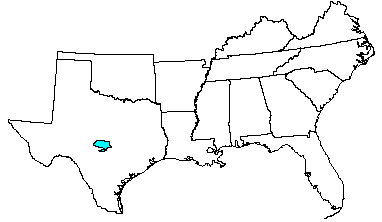

Land use: Most of this area is range. Small acreages are cultivated, and a few are irrigated from ground water. The range is grazed mainly by beef cattle, sheep, and wildlife. Grain sorghum, cotton, peanuts, and small grain for grazing are the principal crops. In a few places, land formerly used for crops is now used as pasture or is reverting to range. Hunting leases for deer, quail, mourning dove, and wild turkey are an important source of income. Fishing camps and other water-based recreation also contribute to the economy. The major concern of management is controlling brush that invades the grasslands.
Elevation and topography: Elevation ranges from 200 to 300 in on valley floors, but on hills and plateaus it ranges from 300 to 400 m. The broad valleys have moderately sloping walls and smooth to undulating floors. The hills are moderately sloping to steep, and the plateaus are broad and gently sloping to undulating.
Climate: Average annual precipitation-625 to 750 mm. About three-fourths of the precipitation falls during the growing season. Average annual temperature-18 to 20 C. Average freeze-free period-210 to 270 days.
Water: The rainfall is adequate for range grasses but is marginal for crops because of extended high temperatures and high evaporation and transpiration rates during the summer. Only a few rivers and large streams flow throughout the year, and irrigation from these sources is limited. Deep wells provide water for some irrigation. Shallow and deep wells and ponds provide water for livestock and for domestic needs.
Soils: Most of the soils are Ustalfs. They are somewhat gravelly and moderately coarse textured and have a thermic temperature regime, an ustic moisture regime, and mixed mineralogy. Deep and moderately deep, nearly level to gently sloping Paleustalfs (Pedernales and Castell series) occur on limy outwash and gneiss. Shallow and moderately deep, gently sloping to sloping Haplustalfs (Click and Oben series) occur in areas underlain by granite and sandstone. Ustochrepts (Keese series) are on the steeper slopes underlain by granite, and Ustorthents (Nebgen series) are on the steeper slopes underlain by sandstone. Shallow to moderately deep, undulating Haplustolls (Harper series) and Argiustolls (Rumple series) are on uplands underlain by limestone.
Potential natural vegetation: This area supports a mixed oak savanna
vegetation of live oak, post oak, and blackjack oak with tall and mid grasses
such as little bluestem, sideoats grama, indiangrass, and switchgrass, sand
and plains lovegrass, green sprangletop, purpletop, pinhole bluestem and
plains bristlegrass. Such forbs as orange zexmania, bushsunflower,
Engelmann-daisy, and trailing ratany grow throughout the area. A mid grass
community with scattered individual or groves of live oak and post oak grows
on the shallow and more droughty soils. Major grass species on these sites
are sideoats grama, meadow dropseed, pinhole bluestem, Arizona cottontop,
vinemesquite, Texas wintergrass, and little bluestem.
(From "Land Resource Regions and Major Land Resource Areas of the United
States". United States Department of Agriculture Soil Conservation Service
Handbook 296. Dec. 1981. pages 56 - 57.)